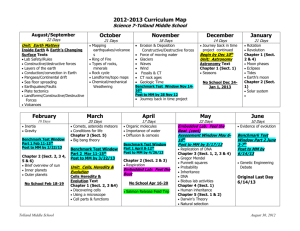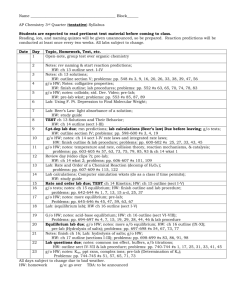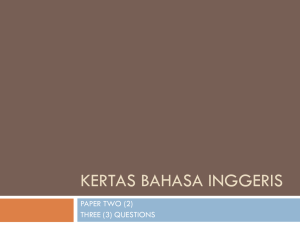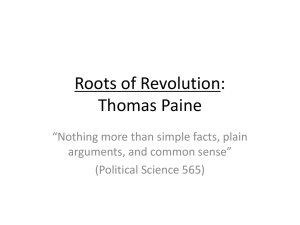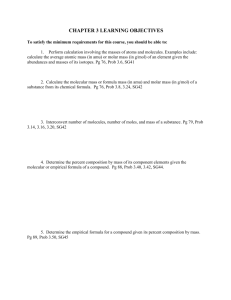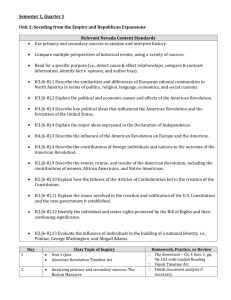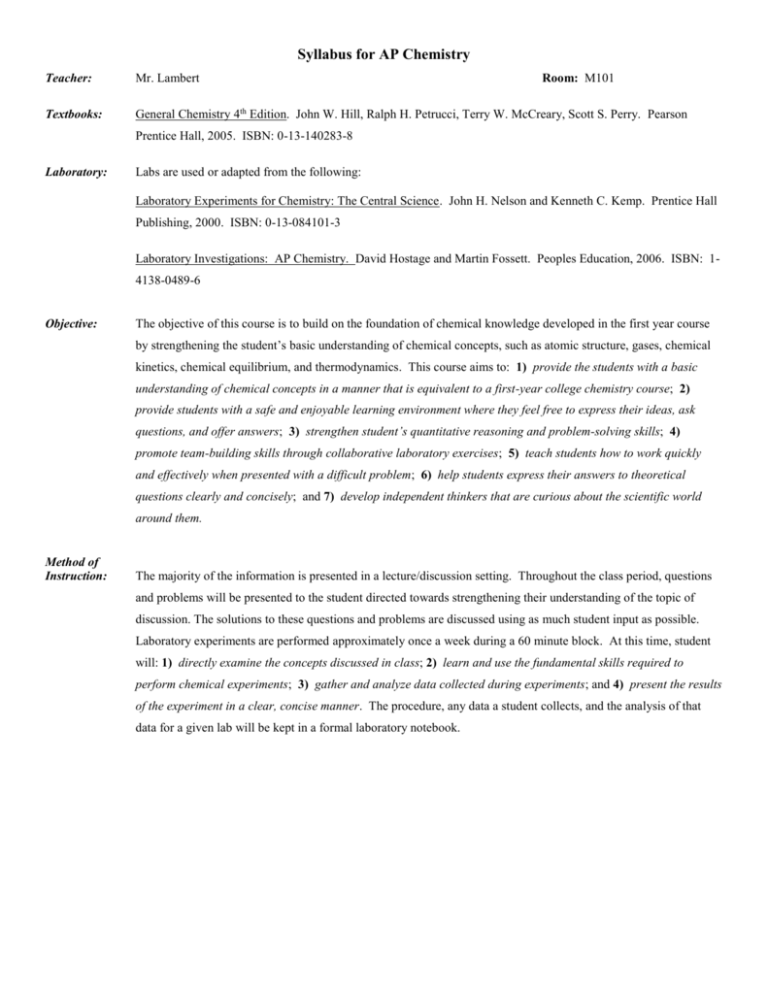
Syllabus for AP Chemistry
Teacher:
Mr. Lambert
Room: M101
Textbooks:
General Chemistry 4th Edition. John W. Hill, Ralph H. Petrucci, Terry W. McCreary, Scott S. Perry. Pearson
Prentice Hall, 2005. ISBN: 0-13-140283-8
Laboratory:
Labs are used or adapted from the following:
Laboratory Experiments for Chemistry: The Central Science. John H. Nelson and Kenneth C. Kemp. Prentice Hall
Publishing, 2000. ISBN: 0-13-084101-3
Laboratory Investigations: AP Chemistry. David Hostage and Martin Fossett. Peoples Education, 2006. ISBN: 14138-0489-6
Objective:
The objective of this course is to build on the foundation of chemical knowledge developed in the first year course
by strengthening the student’s basic understanding of chemical concepts, such as atomic structure, gases, chemical
kinetics, chemical equilibrium, and thermodynamics. This course aims to: 1) provide the students with a basic
understanding of chemical concepts in a manner that is equivalent to a first-year college chemistry course; 2)
provide students with a safe and enjoyable learning environment where they feel free to express their ideas, ask
questions, and offer answers; 3) strengthen student’s quantitative reasoning and problem-solving skills; 4)
promote team-building skills through collaborative laboratory exercises; 5) teach students how to work quickly
and effectively when presented with a difficult problem; 6) help students express their answers to theoretical
questions clearly and concisely; and 7) develop independent thinkers that are curious about the scientific world
around them.
Method of
Instruction:
The majority of the information is presented in a lecture/discussion setting. Throughout the class period, questions
and problems will be presented to the student directed towards strengthening their understanding of the topic of
discussion. The solutions to these questions and problems are discussed using as much student input as possible.
Laboratory experiments are performed approximately once a week during a 60 minute block. At this time, student
will: 1) directly examine the concepts discussed in class; 2) learn and use the fundamental skills required to
perform chemical experiments; 3) gather and analyze data collected during experiments; and 4) present the results
of the experiment in a clear, concise manner. The procedure, any data a student collects, and the analysis of that
data for a given lab will be kept in a formal laboratory notebook.
Method of
Evaluation:
Your grade in this class will determined through your performances on unit tests, weekly quizzes, and homework.
Every student who takes the class is encouraged to take the SAT II Chemistry subject test, but they are required to
take the AP exam.
a. Tests:
Tests will make up 55% of the semester grade. All tests will be weighted equally. There
will be a test at the completion of each unit of study. Each test will be broken down into
two sections: multiple choice and free response. Each section will have a time limit. You
will start with the multiple choice section. At the end of the allotted time, I will collect the
multiple choice section and hand out the free response section. Calculators may only be
used on the free response section.
b. Quizzes:
Quizzes will make up 25% of the semester grade. You will encounter three types of
quizzes in this class: in-class, take-home, and lab. In-class quizzes will be closed-book,
and most will be multiple choice. The take-home quizzes will be adapted from past AP free
response questions dealing with the current topic of discussion. These quizzes will be
open-book, open –note and will be collected at the start of the next class period. Lab
quizzes are designed to evaluate the student’s understanding of the procedure, data
manipulation, and results analysis. The quizzes will also be take-home and collected at the
start of the next class period. If you are not finished with your take-home quiz, you may
ask to leave class to finish it. If you choose to do this, there will be an automatic 5
percentage point penalty on the quiz. If you do not hand in the quiz by the end of the class
period, there will be an addition 5 percentage point penalty AND you will be reported as
having an UNEXCUSED absence from class.
c. Problem Sets: Problem sets grades will make up the final 20% of the semester grade. Selected questions
from the problem set will be due the day after the completion of a section within each unit.
These questions will be graded for correctness. In order to earn full credit on the problem
set, you must show all your work for every question. THERE ARE NO ONE-WORD
ANSWERS IN CHEMISTRY, even though the question may appear to be asking for one.
Always explain your answers. If you are having problems, you’ll need to see me outside of
class.
d. Extra Credit:
Extra Credit can be earned for each unit test. This is an optional exercise although it is one
that I highly recommend. The amount of extra credit given will vary from test to test, but it
will be at least 5 points.
Class Expectations:
1. You should always be prepared for class and ready to begin working as soon as the bell rings. We have a lot of
material to cover, and I always look forward to seeing your smiling faces. If the door is closed upon your arrival
to class, it means that you are tardy. If this occurs more than 5 times over the course of the year, I will double
your minutes when I report them to the Dean’s office. Message: Don’t be late!
2. You should keep all notes, handouts, worksheets, homework assignments, tests, and quizzes together in one
location, preferably in a 3-ring binder that should be specific for this class. Since this is an AP course, the
expectation is that you will master all the material that is covered in the course. In order to master this material,
you WILL have to review it, which is why all your material should be located in one place.
3. You are required to bring a calculator to class. We will be working through a lot of problems in class. Failure to
bring a calculator to class will result in tardy minutes as I will make you go and get your calculator.
4. You are expected to read your textbook, even though you may not be given specific reading assignments. Your
textbook is a great resource, use it.
5. You will treat everyone in the class with respect. This is a hard class, and I know that there will be a lot of
questions. Everyone should feel free to ask those questions and participate in class. If, at any time, I feel you are
being disrespectful to me or your classmates through your words or actions, I will ask you to leave class (and you
will have to deal with the consequences of being dismissed from class).
6. The laboratory is a serious place, and I take it seriously. No horseplay will be tolerated. I expect you to wear
you lab goggles at all times. If labs are not completed in the allotted class time, you will be expected to finish
them outside of class.
7. Major assignments, such as lab reports and projects, will drop 1 letter grade everyday they are overdue. If you
know you will have a problem making a deadline, please talk to me BEFORE the assignment is due.
8. A test or a quiz may be postponed 1 day if you arrive back on campus after 8:30 p.m. from a SCHOOL TRIP the
night before the test is to be taken or the quiz is due. I will expect you to make up the test the following day
either in the morning before classes or during a free period (take-home quizzes will be due the following day at
the start of class).
9. You are expected to make up a missed quiz or test (due to an excused absence) at some point the following day.
It is YOUR responsibility to set up a time with me to make up the missed work. Failure to do so will result in a
zero in the grade book. In the case of unexcused absence, you will receive a 0 on any work due that day,
including any tests or quizzes taken during the class period.
10. You are expected to follow all the school’s policies set forth by the Honor Council and in the Student Handbook.
11. I will allow food and drink into the classroom if it does not disrupt the class. Absolutely no food or drinks will
be allowed in the laboratory area. The classroom is not a garbage can. Clean up after yourself. This is a
privilege, not a right. If you abuse it, it will be taken away.
12. I’m happy to give extra help. I will be in my classroom every morning by 7:15 am. Come see me!
Course Outline:
Unit 1: Gases
Chapter 5: Gases
The student will:
1.
Describe the physical properties of a gas. (Sect. 5.1-5.2)
2.
Define pressure and convert between various units. (Sect. 5.3)
Prob: 21 b & c, 22 a
3.
Understand how open and closed-ended manometers work. (Sect. 5.3)
Prob: 26, 28
4.
Use Boyle’s law to relate pressure and volume to a fixed quantity of gas at a fixed temperature. (Sect. 5.4)
Prob: 32
5.
Use Charles’s law to relate temperature and volume of a fixed amount of gas at a fixed pressure. (Sect. 5.5)
Prob: 38, 39
6.
State Avogardo’s law, define STP, and use the molar volume of gas at STP. (Sect. 5.6)
Prob: 44, 46, 99
7.
List the principles of the kinetic-molecular theory of gases and describe their relationship to the molecular
properties of gases and to the simple gas laws. (Sect. 5.2-5.11)
Prob: 91
8.
Calculate initial and final values of gas variables (n, P, V, T). (Sect. 5.7)
Prob: 47, 50
9.
Calculate unknown properties of a gas (n, P, V, T) using the ideal gas law. (Sect. 5.8)
Prob: 56, 58
10. Be able to manipulate the ideal gas law to calculate the molar mass and the density of a gas. (Sect. 5.8)
Prob: 62, 68, 70, 101, 119 (give molecular formula only)
11. Perform stoichiometric calculations involving gases as reactants or products. (Sect. 5.9)
Prob: 71, 75, 76, 100, 111
12. Apply Dalton’s law of partial pressures to determine the total pressure of a sample of gas or the partial
pressures of individual gases in a mixture of gases. (Sect. 5.10)
Prob: 85, 87
13. Calculate the mole fraction of components of a gas mixture. (Sect. 5.10)
Prob: 84
14. State Graham’s law and apply it to calculating the relative rates of effusion of different gases. (Sect. 5.11)
Prob: 90, 93 a, 120
15. Explain why gases may exhibit nonideal behavior. (Sect. 5.12)
16. Describe the changes that must be made to the ideal gas law when dealing with real gases. (Sect. 5.12)
Laboratories to be performed:
1. Determination of the molar mass of a vapor.
Unit 2: Solution Chemistry
Chapter 12: Physical Properties of Solutions
The student will
1.
Recognize the three types of solutions that can be formed from the three states of matter. (Sect. 12.1)
2.
Describe the influence of intermolecular forces on the energies of solution formation. (Sect. 12.3)
Prob: 43, 82
3.
Distinguish between ideal and non-ideal solutions. (Sect. 12.3)
4.
Predict if a mixture is likely to be homogeneous or heterogeneous based on information about
intermolecular forces. (Sect. 12.3)
5.
Describe the process by which ionic compounds dissolve in water. (Sect. 12.3)
6.
Define solubility; distinguish between saturated, supersaturated, and unsaturated solutions; and extract
solubility data from solubility curves. (Sect. 12.4)
Prob: 46, 48
7.
Describe the effects of temperature and pressure on the solubility of gases. (Sect. 12.5)
8.
Calculate the solubility of gases using Henry’s law. (Sect. 12.5)
Prob: 51
9.
Express solution concentrations in molarity, molality, mole fraction, mass percent, and perform
conversions between the different concentration units. (Sect. 12.2)
Prob: 28, 35, 36, 38
Chapter 4: Chemical Reactions in Aqueous Solutions
Problems: 25, 26, 29, 33, 35, 42, 46, 47, 56, 60, 63, 68, 70, 68, 76, 77, 83, 92, 102, 113, From Ch. 18: 27, 29
The student will
10. Identify strong electrolytes, weak electrolytes, and nonelectrolytes. (Sect. 4.1)
Prob: 25
11. Calculate ion concentrations in solutions of strong electrolytes. (Sect. 4.1)
Prob: 29, 33, 35, 42
12. Differentiate between strong and weak acids, strong and weak bases, and salts. (Sect. 4.2)
Prob: 46, 47
13. Solve stoichiometry problems for reactions between substances that are in solution. (Sect. 4.3)
Prob: 113
14. Describe how a titrations is performed, and carry out calculations related to titrations. (Sect. 4.6)
Prob: 76 b, 77, 83, 92, 102
Laboratories to be performed:
1. Determination of the concentration of an unknown solution using colorimetry.
2. Determination of the mass percent of acetic acid in vinegar (includes the standardization of the sodium
hydroxide solution).
3. Oxidation-reduction titration: Determination of the mass percent of oxalate in an unknown sample.
Unit 3: Understanding Chemical Reactions
The student will
1.
Have a concrete understanding of the solubility rules.
2.
Apply the solubility rules when writing a balanced net ionic equation for a given chemical reaction.
3.
Describe spectator ions in a solution, and be able to write net ionic equations for reactions that occur in
solution. (Sect. 4.3)
4.
Differentiate between the major types of chemical reactions, including but not limited to acid/base,
precipitation, decomposition, synthesis, combustion, and oxidation/reduction.
5.
Predict the products of the major types of chemical reactions.
6.
Assign oxidation numbers to elements in compounds or ions. (Sect. 4.4)
Prob: 68 assign oxidation #’s only. Do not balance.
7.
Define and recognize oxidizing and reducing agents. (Sect. 4.4)
Prob: 70
8.
Balance redox reactions that occur in acidic, basic or neutral solutions. (Sect. 4.4 & 18.2)
Prob in Ch 18: 27, 30
Laboratories to be performed:
1. The Copper Cycle: Various Chemical Reactions of Copper
Unit 4: Chemical Kinetics
Chapter 13: Chemical Kinetics: Rates and Mechanisms of Chemical Reactions
The student will
1.
Describe the kinetics of chemical reactions in terms of the collision theory and the transition state theory.
(Sect. 13.7)
Prob: 51
2.
Construct reaction profiles and identify activation energies, transition states, and reaction enthalpies on
these profiles. (Sect. 13.7)
Prob: 53, 54
3.
Predict the influence of different experimental factors on reaction rates. (Sect. 13.1)
4.
Express reaction rates in terms of concentrations of reactants and/or products and use experimental data to
determine the average rate and/or instantaneous rate of reaction. (Sect. 13.2 – 13.3)
Prob: 23, 24, 25 a & b, 33, 75
5.
Use the method of initial rates to determine the rate law and rate constant of a chemical reaction, as well as
apply the rate law to determine the rate of reaction at different reactant concentrations. (Sect. 13.4)
Prob: 32
6.
Relate concentration of reactants and time using the integrated for zero-, first-, and second-order reactions.
(Sect. 13.5 -13.6)
Prob: 27, 30, 35, 40, 42, 43, 46
7.
Explain the meaning of half-life, and derive and use equations for half-life of zero-, first-, and second-order
reactions. (Sect. 13.5 -13.6)
Prob: 39, 45, 50
8.
Calculate the effects of temperature on rates of reaction, using the Arrhenius equation. (Sect. 13.8)
Prob: 56, 57, 80
9.
Describe the properties of elementary reactions and rate determining step in a reaction mechanism. (Sect. 13.9)
10. Deduce rate laws from simple reaction mechanisms, and establish the plausibility of reaction mechanisms
based on kinetic data. (Sect. 13.9)
Prob: 62, 64, 65, 68, 85
11. Describe the effects of a catalyst on the rate of reaction. (Sect. 13.10)
Laboratories to be performed:
1. Determination of the Order of a Chemical Reaction
Unit 5: Chemical Equilibrium: An introduction
Chapter 14: Chemical Equilibrium
The student will
1.
Describe the nature of dynamic equilibrium in terms of forward and reverse processes. (Sect. 14.1)
2.
Write the equilibrium constant expression for reversible chemical reactions. (Sect. 14.2)
Prob: 10, 12
3.
Derive equilibrium constants for other reactions related to a given reaction with a known equilibrium
constant. (Sect. 14.3)
Prob: 22, 24, 30
4.
Derive the equilibrium constant for an overall reaction obtained by combining two or more reactions and
their equilibrium constants. (Sect. 14.3)
Prob: 26
5.
Distinguish between Kc and Kp, and obtain the value for one of them from a known value of the other.
(Sect. 14.3)
Prob: 20, 23
6.
Determine the value of the equilibrium constants from experimental data. (Sect. 14.5)
Prob: 32, 34, 57, 58
7.
Given initial concentrations, calculate equilibrium concentrations or partial pressure using the given
equilibrium constant. (Sect. 14.5)
Prob: 60, 62, 69, 72, 81
8.
Describe nonequilibrium conditions through a reaction quotient, and use this value to predict the direction
in which a net reaction must occur to achieve equilibrium. (Sect. 14.3)
Prob: 49, 52, 66
9.
Use LeChâtelier’s principle to predict shifts in equilibria following changes in concentration, temperature,
pressure, or the addition of a catalyst. (Sect. 14.4)
Prob: 39, 43, 75
10. Use the van’t Hoft equation to determine the value of the equilibrium constant at a different temperature.
(Sect. 17.7 (note different chapter)
Prob: 88
Chapter 16: More Equilibria in Aqueous Solutions: Slightly Soluble Salts and Complex ions
The student will
11. Write expressions for Ksp describing solubility of slightly soluble salts. (Sect. 16.1)
Prob: 19, 20, 21, 22
12. Calculate Ksp values from the molar solubility of salts and vice versa. (Sect. 16.2)
Prob: 25, 28, 30, 32, 35
13. Predict and calculate the effect of addition of a common ion on the solubility of a salt. (Sect. 16.3)
Prob: 38, 40, 41, 43
14. Use the reaction quotient to determine whether a precipitation will occur when two ions are mixed . (Sect. 16.4)
Prob: 47, 49, 50, 53, 58, 60
15. Predict and calculate the effect of pH on the solubilities of salts. (Sect. 16.5)
Prob: 64, 66, 90, 94, 100
16. Using formation constants of complex ions, determine the concentrations of ions in solutions containing
complex ions. (Sect. 16.6)
Prob: 68, 70, 71, 73, 76
Laboratories to be performed:
1. Examination of LeChâtelier’s Principle in a Microplate System.
2. Determining the Ksp of Calcium Hydroxide.
Unit 6: Acid/Base Equilibria and Solubility Equilibria
Chapter 15: Acids, Bases, and Acid/Base Equilibria
The student will
1.
Define acids and bases according to the Arrhenius, Brønsted-Lowry, and Lewis theories. (Sect. 15.1 & 15.11)
2.
Write equilibrium constant expressions for Brønsted-Lowry acid and bases, and describe what is meant by
conjugate acid/base pairs. (Sect. 15.1)
Prob: 24, 26, 28
3.
Predict the influences of molecular structure on the relative strengths of acids and bases. (Sect. 15.2)
Prob: 31, 32
4.
Relate equilibrium values of [H3O+] and [OH-] to another by using the ion product of water. (Sect. 15.3)
Prob: 38
5.
Determine values of conjugate acid and conjugate base ionization constants through their relationship to
Kw. (Sect. 15.3)
Prob: 67 a & b
6.
Calculate the pH value for strong acids, strong bases, weak acids, and weak bases. (Sect. 15.3 – 15.5)
Prob: 42, 47, 48, 49, 52, 54, 56, 59
7.
Calculate the pH of salt solutions (Sect 15.6)
Prob: 63, 65, 67 c; 6, 77
8.
Predict and calculate the effect of pH on the solubility of salts. (Sect. 16.5)
Prob:( In Chapter 16) 48, 64, 66, 90, 94, 100
9.
Describe the common ion effect, and predict the influence on acid/base equilibria of adding common ions
to a solution. (Sect. 15.7)
Prob: 71
10. Calculate equilibrium concentrations and pH values for solutions of weak acids and weak bases containing
common ions. (Sect. 15.8)
Prob: 73, 74, 75, 76
11. Describe the action of a buffer solution, and calculate equilibrium concentrations and pH values of such
solutions using either Ka or Kb values or the Henderson-Hasselbalch equation. (Sect. 15.8)
Prob: 81, 82, 83, 84, 103, 122
12. Calculate the effect on the pH produced by adding a strong acid or strong base to a buffer solution, and
describe the pH range and buffer capacity of the solution. (Sect. 15.8)
Prob: 85, 86, 88, 106
13. Describe the function of an acid/base indicator and the relationship between pH and the color of the indicator, select
appropriate indicators for a given pH range, and determine the color of an indicator in a given solution. (Sect. 15.9)
Prob: 90
14. Describe the regions of a titration curve in terms of equilibria that exist at different points along curve. Calculate the
pH values a various points along the curve, and determine the Ka value of the acid using the curve. (Sect. 15.10)
Prob: 97, 99, 128
Laboratories to be performed:
1. Determination of the Acid Ionization Constant of a Weak Acid.
2. Preparation of a Buffer Solution at a Given pH.
3. Determination of the Equilibrium Constant of an Indicator.
Unit 7: Thermodynamics
Chapter 6: Thermochemistry
The student will
1.
Define and distinguish between kinetic energy, potential energy, and internal energy. (Sect. 6.1 – 6.2)
2.
Identify systems and surroundings and describe the three types of thermodynamic systems. (Sect. 6.2)
Prob: 1
3.
Describe the transfer of heat between a system and its surroundings and what is meant by thermal
equilibrium. (Sect. 6.4)
4.
State and apply the law of conservation of energy and the first law of thermodynamics. (Sect. 6.3)
5.
Describe what is meant by a state function. (Sect. 6.4)
Prob: 4
6.
Define and apply the terms exothermic and endothermic reaction. (Sect. 6.4)
7.
Perform calculations involving enthalpy changes in chemical reactions. (Sect. 6.4)
Prob: 28, 30, 34, 35, 38, 40, 42, 92 (use info found in 79)
8.
Perform calorimetric calculations. (Sect. 6.5)
Prob: 46 a, 49, 51, 54, 56, 57, 60, 99
9.
State Hess’s law of constant summation, explain its significance, and apply it. (Sect. 6.6)
Prob: 67, 70
10. Understand the meanings of standard state, the standard enthalpy of reaction, and the standard enthalpy of
formation. (Sect. 6.7)
11. Use bond energies to calculate the enthalpy change for a chemical reaction (Sect. 9.10)
Prob: (in Ch. 9) 69, 70
12. Use standard enthalpy of formations to determine standard enthalpy changes for chemical reactions. (Sect. 6.7)
Prob: 72 b & c, 74, 97
Chapter 17: Thermodynamics: Spontaneity, Entropy, and Free Energy
The student will
13. Describe the differences between spontaneous and nonspontaneous processes. (Sect. 17.2)
14. Define entropy and describes its relationship with spontaneous processes. (Sect. 17.3)
Prob: 24
15. State the second and third law of thermodynamics. (Sect. 17.3)
16. Predict the relative entropy change for a given process. (Sect. 17.3)
Prob: 19, 26
17. Relate the value of entropy and enthalpy to the spontaneity of a given process. (Sect. 17.4)
18. Determine Gibbs free energy and relate the value to the spontaneity of a given process. (Sect. 17.4 – 17.5)
Prob: 30, 36, 38, 40
19. Calculate the equilibrium constant from Gibbs free energy. Relate the magnitude and sign of Gibbs free
energy to the position of equilibrium of a given process. (Sect. 17.6)
Prob: 45, 49, 54, 55, 57
20. Calculate Gibbs free energy for a given process under nonstandard conditions. (Sect. 17.6)
Prob: 44, 61, 70, 82
Laboratories to be performed:
1. Determining the Enthalpy change of a Chemical Reaction using Hess’s Law.
Unit 8: Electrochemistry
Chapter 18: Electrochemistry
The student will
1.
Describe the basis of electrochemical cells in terms of oxidation-reduction reactions. (Sect. 18.1 – 18.2)
Prob: 28, 30
2.
Describe a voltaic cell and the parts that make up a voltaic cell. (Sect. 18.3)
3.
Use standard reduction potentials to calculate standard cell potential for a voltaic cell. (Sect. 18.4)
Prob: 33, 36, 38, 40, 42
4.
Relate the standard cell potential to the spontaneity of the voltaic cell. (Sect. 18.5)
Prob: 44, 46, 48
5.
Calculate Gibbs free energy and the equilibrium constant for voltaic cells at standard conditions. (Sect. 18.5);
Prob: 52, 54, 56, 107
6.
Determine cell potentials under nonstandard conditions using the Nernst equation. (Sect. 18.6)
Prob: 58, 60, 61, 64, 97
7.
Use the Nernst equation to calculate potentials of concentration cells. (Sect. 18.6)
Prob: 102
8.
Describe the relationship between voltaic cells and various kinds of batteries. (Sect. 18.7)
9.
Describe electrolysis and calculate the amount of substances consumed or produced during electrolysis
reactions. (Sect. 18.9 – 18.10)
Prob: 77, 80, 82, 83, 91
Laboratories to be performed:
1. Using Concentration Cells to Determine the Concentration of an Unknown Solution.
Unit 9: Nuclear Chemistry
Chapter 19: Nuclear Chemistry
The student will
1.
Describe the basic nature of α, β−, and γ radiation. (Sect. 19.1)
2.
Write and balance nuclear equations involving the five different decay modes of radioactive nuclides.
(Sect. 19.1)
`
Prob: 22, 23 a, 24 a & b, 26
3.
Predict the products of a radioactive decay series. (Sect. 19.2)
Prob: 23 b & c, 24 c
4.
Calculate decay rates and half-lives of radioactive isotopes. (Sect. 19.3)
Prob: 29, 30, 31, 38, 39, 84, 88 a, 90 a & b
5.
Predict the nuclear stability of specific isotopes, using magic numbers and the belt of stability. (Sect. 19.6)
Prob: 59, 60
6.
Relate mass changes to energy changes in nuclear equations through calculations involving E = mc2.
(Sect. 19.7);
Prob: 49, 52, 54, 55
7.
Describe the use of nuclear fission and nuclear fusion in energy production. (Sect. 19.8)
Prob: 66
Unit 10: Electronic Structure
Chapter 7: Atomic Structure
The student will
1.
Describe how a cathode ray tube works and the major results of Thomson’s experiments. (Sect. 7.1)
Prob: 24
2.
Describe how Millikan’s experiments were used to determine the charge of the electron. (Sect. 7.1)
Prob: 70
3.
Explain the results of Rutherford’s gold foil experiment and how these results led to Rutherford’s nuclear
model of the atom. (Sect. 7.2)
4.
Explain the differences between Thomson’s plum pudding model of the atom and Rutherford’s nuclear
model of the atom. (Sect. 7.2)
5.
Describe the properties of a proton and neutron and how they were discovered. (Sect. 7.3)
6.
Calculate the wavelength, frequency, and/or energy of electromagnetic radiation. (Sect. 7.5-7.6)
Prob: 38, 39, 43, 74
7.
Describe the difference between continuous and line spectra. (Sect. 7.5)
8.
Describe the Bohr model of the hydrogen atom. (Sect. 7.7)
Prob: 77, 78
9.
Calculate the energy of an electron in a given energy level of a hydrogen atom and the energy differences
in the levels. (Sect. 7.7)
Prob: 48
10. Describe the wave properties of matter and the nature of wave mechanics and wave function. (Sect. 7.8)
Prob: 54, 56
11. Have an understanding of quantum numbers, their possible values, and their relationship to atomic orbitals. (Sect. 7.9)
Prob: 61, 62, 65, 66
12. Describe the meaning of atomic orbitals and the shapes of s, p, and d orbitals. (Sect. 7.9)
Chapter 8: Electron Configurations, Atomic Properties, and the Periodic Table
The student will
13. Explain the origin of energy differences between the orbitals of a hydrogen atom and those of a multielectron
atom and between different subshells within a principle shell of a multielectron atom.
(Sect. 8.1)
14. Write electron configurations using spdf notation and orbital diagrams of atoms and ions. (Sect. 8.2)
Prob: 28 b, e, g, & i, 30 b, c, & d, 32 b & d, 35 b & c, 38
15. Apply the Pauli exclusion principle, Hund’s rule, and the Aufbau, principle to the writing of electron
configurations. (Sect. 8.3-8.4)
Prob: 22, 24, 26
16. Deduce electron configurations of atoms based on their position in the periodic table. (Sect. 8.5)
Prob: 44, 75, 76
Unit 11: Periodic Properties, Chemical Bonding, and Molecular Geometries
Chapter 8: Electron Configurations, Atomic Properties, and the Periodic Table
The student will
1.
Predict the magnetic properties of atoms and ions. (Sect. 8.6)
Prob: 46
2.
Define atomic and ionic radius, ionization energy, electron affinity, and electronegativity, and describe the
trends of each as they relate to the periodic table. (Sect. 8.7)
Prob: 52, 54, 56, 58, 59, 62
3.
Describe the characteristic properties of metals, metalloids, and nonmetals. (Sect. 8.8)
Prob: 68
4.
Explain trends in macroscopic properties of elements. (Sect. 8.9)
Prob: 70
Chapter 9: Chemical Bonds
The student will
5.
Describe the energetics of chemical bond formation. (Sect. 9.5)
Prob: 27, 30
6.
Cite the characteristics of ionic and covalent bonds. (Sect. 9.2 - 9.3)
Prob: 23
7.
Describe the nature of multiple bonds in terms of shared electron pairs. (Sect. 9.6)
8.
Describe the influence of electronegativity on chemical bonding and bond polarity. (Sect. 9.7)
Prob: 40, 42
9.
Draw Lewis dot structures for molecules and ions, including any exceptions. (Sect. 9.8 – 9.9)
Prob: 36, 38, 56, 62, 101
10. Calculate formal charges and use them in assessing the plausibility of Lewis dot structures. (Sect. 9.8)
Prob: 46, 48
11. Draw resonance structures when appropriate and describe the resonance hybrid. (Sect. 9.8)
Prob: 50
12. Define bond length, describe the general relationship between bond length and bond order, and predict
bond lengths for the Lewis structures. (Sect. 9.10)
Prob: 64, 67, 91
Chapter 10: Bonding Theory and Molecular Geometry
The student will
13. Identify the geometrical shapes of molecules and polyatomic ions according to the principles of the VSEPR
theory. (Sect. 10.1)
Prob: 25, 26, 27, 28, 31
14. Predict the bond angles within a molecule and influence of lone pairs on bond angles. (Sect. 10.1)
Prob: 33, 35
15. Describe the shape of molecules having more than one central atom. (Sect. 10.1)
Prob: 36
16. Define a dipole moment and categorize molecules as polar or nonpolar. (Sect. 10.2)
Prob: 38, 40, 77
17. Describe the valence bond theory of covalent bond formation. (Sect. 10.3)
18. Describe hybridization of atomic orbitals in terms of orbital energy and spatial orientation, and predict the
central atom hybridization and atomic orbital overlap associated with covalent bond formation. (Sect. 10.4)
Prob: 45, 48, 50, 51, 84
19. Describe the hybridization schemes that lead to multiple bond formation, and identify the sigma and pi
bonds present in a given molecular structure. (Sect. 10.5)
Prob: 56
20. Describe cis-trans isomers and the bonding that lead to them. (Sect. 10.5)
Prob: 57
21. Draw and name simple aromatic structures. (Sect. 10.9)
Prob: 69, 70, 71, 72
Unit 12: Intermolecular Forces, Liquids, and Solids
Chapter 11: States of Matter and Intermolecular Forces
The student will
1.
Describe the differences between dispersion, dipole-dipole, dipole-induced-dipole forces, and hydrogen
bonding. (Sect. 11.5 – 11.6)
2.
Determine the type of intermolecular force present in a given compound. (Sect. 11.5 – 11.6)
3.
Describe the origin of intermolecular forces, and predict physical properties of the substances from the
nature of their intermolecular forces. (Sect. 11.5 - 11.6)
Prob: 49, 51, 55, 58
4.
Describe the distinguishing characteristics of the three states of matter, and identify and describe the six
main types of phase changes. (Sect. 11.1)
5.
Perform calorimetric calculations related to phase changes. (Sect. 11.2 - 11.3)
Prob: 38, 39
6.
Define vapor pressure, boiling point, melting point, surface tension, and viscosity, and relate each to the
type of force found in a substance. (Sect. 11.2, 11.3, 11.7)
Prob: 60, 74, 92
7.
Perform calculations related to vapor pressure. (Sect. 11.2)
Prob: 29, 31, 73, 83
8.
Use the Clausius-Clapeyron equation to determine vapor pressures of a substance at different temperatures.
(Sect. 17.7)
Prob: (in Ch. 17) 63, 64
9.
Construct and interpret phase diagrams. (Sect. 11.4)
Prob: 44, 45, 93
10. Compare the properties of ionic, molecular, metallic, and network-covalent solids. (Sect. 11.8 – 11.9)
11. Discuss the organization of atoms/molecules in a crystalline solid in terms of unit cells and close-packed
crystal structure. (Sect. 11.10)
Prob: 64
Chapter 12: The Physical Properties of Solutions
The student will
12. Explain the effects of a solute particle on the freezing point, boiling point, and vapor pressure of a pure
liquid. (Sect. 12.6 – 12.7)
13. Discuss the differences between electrolytic and nonelectrolytic solutes using the van’t hoft factor.
(Sect. 12.9)
14. Calculate the vapor pressure of a solution using Raoult’s law, and explain variations to Raoult’s law found
in non-ideal solutions. (Sect. 12.6)
Prob: 55, 56
15. Describe the process of fractional distillation in relation to the vapor pressures of solution components.
(Sect. 12.6)
16. Calculate changes in freezing point and boiling point of a liquid due to the presence of a solute. (Sect. 12.7);
Prob: 57, 60, 75, 87, 91
17. Calculate the osmotic pressure of a solution. (Sect. 12.8)
Prob: 69, 70
18. Calculate the molar mass of an unknown substance from freezing point, boiling point, or osmotic pressure
data. (Sect. 12.7 – 12.8)
Prob: 62, 63, 97
19. Discuss ion pairing and its effect on a given colligative property. (Sect. 12.9)
Prob: 71, 72
Laboratories to be performed:
1. Determining the Molar Mass of an Unknown Substance by Freezing Point Depression

